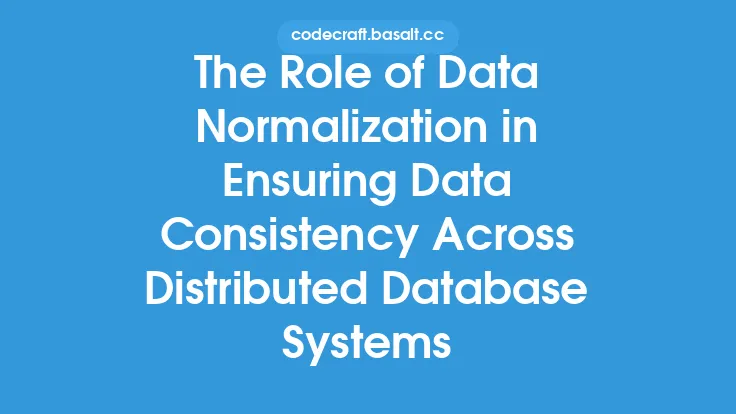Data normalization is a crucial aspect of maintaining data integrity in database systems. It involves organizing data in a way that minimizes data redundancy and dependency, making it easier to maintain and update. Normalization helps to ensure that data is consistent and reliable, which is essential for making informed decisions and taking actions based on that data. In this article, we will explore the importance of data normalization in maintaining data integrity and discuss the key concepts and techniques involved.
Introduction to Data Normalization
Data normalization is the process of organizing data in a database to minimize data redundancy and dependency. It involves dividing large tables into smaller tables and linking them through relationships, making it easier to maintain and update data. Normalization helps to eliminate data anomalies, such as insertion, update, and deletion anomalies, which can occur when data is not properly organized. By normalizing data, database administrators can ensure that data is consistent and reliable, which is essential for making informed decisions and taking actions based on that data.
Benefits of Data Normalization
Data normalization offers several benefits, including improved data consistency, reduced data redundancy, and improved data integrity. By normalizing data, database administrators can ensure that data is consistent across the database, reducing the risk of errors and inconsistencies. Normalization also helps to reduce data redundancy, which can occur when data is duplicated across multiple tables. This can help to improve data storage efficiency and reduce the risk of data inconsistencies. Additionally, normalization helps to improve data integrity by ensuring that data is accurate and reliable, which is essential for making informed decisions and taking actions based on that data.
Key Concepts in Data Normalization
There are several key concepts involved in data normalization, including tables, rows, columns, and relationships. Tables are used to store data in a database, with each table consisting of rows and columns. Rows represent individual records, while columns represent fields or attributes. Relationships are used to link tables together, enabling database administrators to access and manipulate data across multiple tables. Normalization involves dividing large tables into smaller tables and linking them through relationships, making it easier to maintain and update data.
Normalization Techniques
There are several normalization techniques, including first normal form (1NF), second normal form (2NF), and third normal form (3NF). First normal form involves eliminating repeating groups, which can occur when a table contains multiple columns with the same name. Second normal form involves eliminating partial dependencies, which can occur when a column depends on only one part of a composite key. Third normal form involves eliminating transitive dependencies, which can occur when a column depends on another column that is not part of the key. By applying these normalization techniques, database administrators can ensure that data is properly organized and maintained.
Data Anomalies and Normalization
Data anomalies can occur when data is not properly normalized, resulting in errors and inconsistencies. Insertion anomalies can occur when data is inserted into a table, but the data is not properly related to other tables. Update anomalies can occur when data is updated in one table, but the changes are not properly reflected in other tables. Deletion anomalies can occur when data is deleted from a table, but the deletion is not properly reflected in other tables. By normalizing data, database administrators can eliminate these anomalies and ensure that data is consistent and reliable.
Best Practices for Data Normalization
There are several best practices for data normalization, including using meaningful table and column names, avoiding redundant data, and using relationships to link tables together. Database administrators should also use normalization techniques, such as 1NF, 2NF, and 3NF, to ensure that data is properly organized and maintained. Additionally, database administrators should regularly review and update data to ensure that it remains consistent and reliable.
Data Normalization and Data Quality
Data normalization is closely related to data quality, as it helps to ensure that data is accurate and reliable. By normalizing data, database administrators can eliminate errors and inconsistencies, resulting in higher-quality data. Data quality is essential for making informed decisions and taking actions based on that data, as poor-quality data can lead to incorrect conclusions and decisions. By prioritizing data normalization and data quality, organizations can ensure that their data is reliable and trustworthy.
Data Normalization in Distributed Database Systems
Data normalization is particularly important in distributed database systems, where data is stored across multiple locations. In these systems, data normalization helps to ensure that data is consistent across all locations, reducing the risk of errors and inconsistencies. By normalizing data, database administrators can ensure that data is properly replicated and updated across all locations, resulting in improved data integrity and reliability.
Conclusion
In conclusion, data normalization is a crucial aspect of maintaining data integrity in database systems. By normalizing data, database administrators can ensure that data is consistent and reliable, reducing the risk of errors and inconsistencies. Normalization helps to eliminate data anomalies, improve data storage efficiency, and improve data quality. By prioritizing data normalization, organizations can ensure that their data is reliable and trustworthy, resulting in better decision-making and improved business outcomes.





